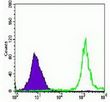PARP1 Mouse Monoclonal Antibody [Clone ID: 7A10]
Other products for "PARP1"
Specifications
| Product Data | |
| Clone Name | 7A10 |
| Applications | FC, WB |
| Recommended Dilution | WB: 1:500-2000, IF: 1:200-400 |
| Reactivities | Human |
| Host | Mouse |
| Clonality | Monoclonal |
| Immunogen | A synthetic peptide corresponding to residues before the cleavage site of human PARP-1 was used as immunogen. The antibody only recognizes full-length form (p116) of PARP-1. |
| Formulation | Supplied in 10 mM HEPES sodium (pH 7.5), 150 mM NaCl, 100 µg/ml BSA, 50% glycerol, and 0.03% sodium azide |
| Purification | N/A |
| Conjugation | Unconjugated |
| Storage | Store at -20°C as received. |
| Stability | Stable for 12 months from date of receipt. |
| Gene Name | poly(ADP-ribose) polymerase 1 |
| Database Link | |
| Background | PARP, a 116 kDa nuclear poly (ADP-ribose) polymerase, appears to be involved in DNA repair in response to environmental stress. This protein can be cleaved by many ICE-like Caspases in vitro and is one of the main cleavage targets of caspase-3 in vivo. In human PARP, the cleavage occurs between Asp214 and Gly215, which separates the PARP amino-terminal DNA binding domain (24 kDa) from the carboxy-terminal catalytic domain (89 kDa). PARP helps cells to maintain their viability; cleavage of PARP facilitates cellular disassembly and serves as a marker of cells undergoing apoptosis. |
| Synonyms | ADPRT; ADPRT 1; ADPRT1; ARTD1; pADPRT-1; PARP; PARP-1; PPOL |
| Reference Data | |
| Protein Families | Druggable Genome, Stem cell - Pluripotency, Transcription Factors |
| Protein Pathways | Base excision repair |
Documents
| Product Manuals |
| FAQs |
{0} Product Review(s)
0 Product Review(s)
Submit review
Be the first one to submit a review
Product Citations
*Delivery time may vary from web posted schedule. Occasional delays may occur due to unforeseen
complexities in the preparation of your product. International customers may expect an additional 1-2 weeks
in shipping.






























































































































































































































































 Germany
Germany
 Japan
Japan
 United Kingdom
United Kingdom
 China
China




